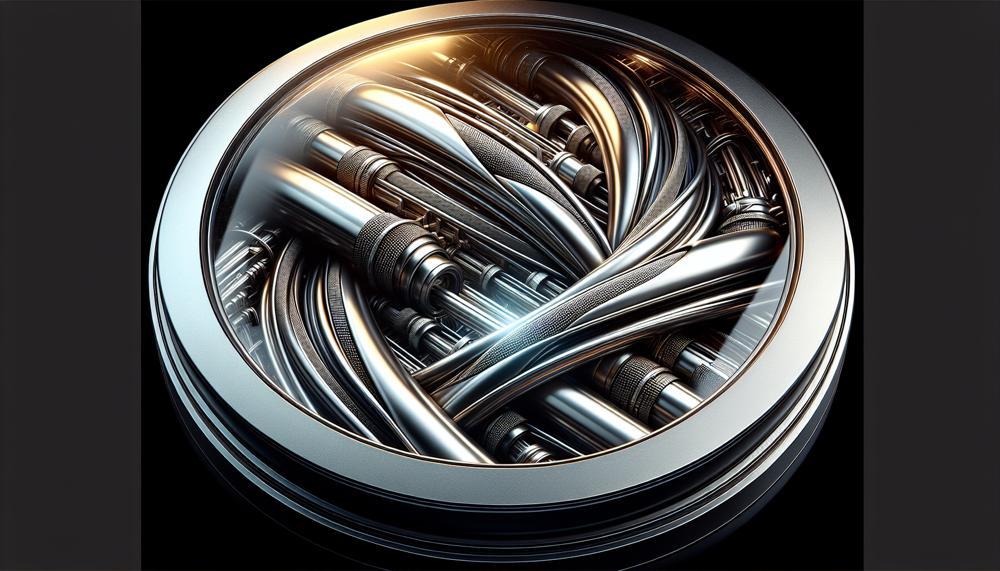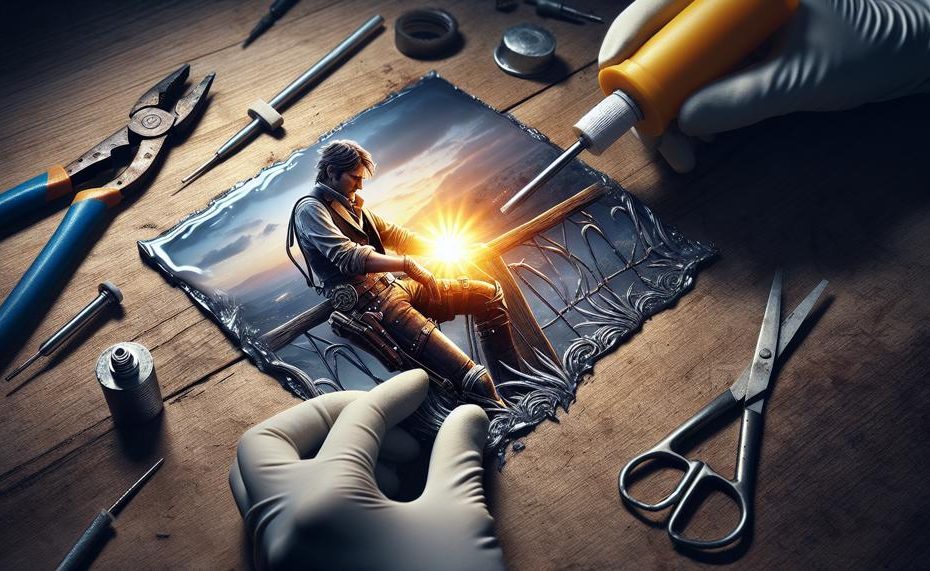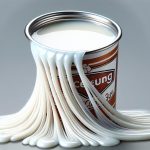Are you ready to elevate your DIY game and create stunning pieces of art or furniture? Want to add a touch of sophistication and modernity to your home decor? Look no further, because we have the perfect solution for you – bonding metal and glass together.
This technique may seem intimidating at first, but fear not, as with the right tools and techniques, it can be easily accomplished.
In this blog post, we will guide you through the process of bonding metal and glass. We’ll cover everything from essential materials to step-by-step instructions.
Get ready to learn all the ins and outs of this fascinating craft:
- The crucial role of choosing the correct adhesive for metal and glass
- Various types of adhesives suitable for bonding metal and glass
- Detailed steps on how to properly bond metal and glass
- Pro tips for achieving a sturdy and long-lasting bond between metal and glass
- Creative ways to incorporate bonded metal and glass into your home decor or DIY projects
Prepare to unleash your inner artist. Become a master at bonding metal and glass with our comprehensive guide.
Let’s dive in.
Table of Contents
Factors to Consider When Choosing Adhesive for Bonding Metal to Glass
When choosing an adhesive to bond metal to glass, there are several crucial factors to consider. These factors include the time it takes for the adhesive to cure, its strength, flexibility, and compatibility with materials. Also important are time availability, versatility, and cost.
Each of these elements plays a significant role in determining the best adhesive for a specific application.
It is essential to conduct thorough research and fully understand your bonding needs before making a decision. This will help you avoid potential problems and additional costs down the line.
In addition to these primary considerations, also keep in mind other factors. These include resistance to temperature, weight, and stress, aesthetic appeal, and chemical resistance.
Different types of adhesives offer unique properties and benefits. Epoxy adhesive is known for its exceptional bonding strength. It can withstand extreme temperatures and chemicals.

On the other hand, cyanoacrylate glue offers quick curing time and versatility in bonding various materials.
Silicone adhesive boasts flexibility over time and resistance to moisture, temperature changes, and chemicals.
UV-curing adhesives are also an option with rapid curing time and high bond strength. However, they require careful consideration of compatibility and the needed strength.
Proper surface preparation is crucial for achieving optimal adhesion when bonding metal to glass. This includes thoroughly cleaning the surfaces and removing any coatings or contaminants. If necessary, roughen them up, and allow them to dry completely before applying primer (if needed).
It is also essential to follow the manufacturer’s instructions carefully for best results. Application methods may vary depending on the type of adhesive used.
How to Glue Metal to Glass
When choosing a glue to adhere metal to glass, you can consider the following factors:
- Type of glue: Epoxy and cyanoacrylate-based adhesives are both good options. Epoxy is a two-part adhesive that creates a strong bond between glass and metal. It’s durable, resistant to water, heat, and chemicals, and comes in clear versions. Super glue is easy to use and good for small household objects.
- Placement: If you need more time to position the glass on the metal, an epoxy might be better.
- Other materials: Other options include silicone and UV-curing adhesives.
Here are some specific glues you can use for glass to metal:
Loctite Glass Glue
This super glue is specially formulated for bonding glass. It’s water and dishwasher resistant, dries in seconds, and leaves invisible bonds.
Loctite Extreme Glue Gel
This all-purpose clear glue can be used on glass, metal, stone, wood, and rubber.
Permabond UV glues
These glues form high-strength bonds. They are suitable for decorative and structural glass bonding.
Epoxy Adhesive
Epoxy adhesives are a widely used and powerful type of glue that can bond various materials together.
A mixture of resin and hardener, they create a strong bond when combined in equal parts and exposed to heat. This chemical reaction allows for a durable bond between metal and glass, as well as other materials such as wood, plastic, concrete, and stone.
Epoxy adhesives have an impressive tensile strength of up to 6000 PSI. They also resist external hazards like water, heat, and solvents. This makes them ideal for bonding metal to glass. However, their working time is limited to only 10 minutes, and it takes 24-48 hours for them to fully cure.
Once cured, it can only be scraped off.
Cyanoacrylate Glue (Super Glue)
When it comes to joining metal and glass, the most effective type of glue is epoxy adhesive.
This powerful adhesive offers exceptional bonding strength. It has high resistance to temperature and chemicals, and moisture. This makes it an ideal choice for a variety of applications involving metal and glass. Epoxy adhesives have a working time of 10 minutes, allowing for proper positioning before curing. They take 24-48 hours to fully cure.
In addition, once cured, they are transparent, enhancing the visual appeal of any project.
Silicone Adhesive
Silicone adhesive provides numerous advantages when it comes to bonding metal to glass. Notable benefits of this material include its resilience and flexibility. It is resistant to weather and chemicals, and versatile. It’s important to follow proper surface preparation. Also, follow the manufacturer’s instructions for optimal bonding.
Let’s take a closer look at these advantages.
Resilient Flexibility:
One of the key advantages of silicone adhesive is its flexibility. This makes it an excellent choice for projects where metal and glass need to expand or contract together.
Unlike other adhesives that can become brittle over time, silicone adhesive maintains its flexibility. This ensures a long-lasting bond between metal and glass.
Weatherproof and Chemical-Resistant:
Silicone adhesive is also beneficial for metal-to-glass bonding. It can withstand extreme temperatures and harsh chemicals.
This makes it ideal for outdoor projects. It is also good for applications where the materials will face tough environmental conditions.
Versatility:
Silicone adhesive is versatile, meaning it can bond various types of metals to different glass substrates.
This makes it suitable for a wide range of applications, including automotive, construction, and household repairs.
Proper Surface Preparation is Crucial:
To achieve optimal adhesion between metal and glass using silicone adhesive, it is crucial to properly prepare the surfaces.
This includes thoroughly cleaning them, removing any existing coatings or debris, and roughening them up to provide a better bonding surface.
Following Manufacturer’s Instructions:
As with any adhesive, it is crucial to follow the manufacturer’s instructions for proper application. Each adhesive has its own formula. It also has specific requirements for achieving maximum bonding strength.
Additionally, it is essential to follow safety precautions outlined by the manufacturer for a successful and safe project.
UV-Curing Adhesives
UV-curing adhesives have gained significant popularity. They are the go-to solution for bonding metal to glass due to the multitude of benefits they offer.
These adhesives boast a fast curing time, robust bond strength, and resistance to environmental factors. They also have low VOC content and a clean and efficient application process.
Additionally, the transparent bond line and compatibility with a wide range of materials make UV-curing adhesives an ideal choice for numerous industries. They also have a longer shelf life. These include automotive, electronics, and medical devices.
I can personally attest to the effectiveness and efficiency of UV-curing adhesives in bonding metal to glass. The quick curing time of these adhesives has allowed for faster production processes. It saves time and money for companies. UV-curing adhesives have strong bond strength. They ensure durable and reliable bonds between metal and glass.
Moreover, resistance to environmental factors is crucial in industries. Exposure to harsh conditions is common. In my experience, UV-curing adhesives have proven to be highly resistant to temperature changes, moisture, and chemicals. They are a top choice for various applications.
Not only that, but the low VOC content of UV-curing adhesives also makes them environmentally friendly. This is especially important for companies. They are looking to reduce their carbon footprint and adhere to strict environmental regulations.
Surface Preparation for Bonding Metal to Glass
Successfully bonding metal and glass requires proper surface preparation. This involves three key steps: cleaning, degreasing, and roughening.
- Cleaning: The first step is to thoroughly clean the metal and glass surfaces to remove any dirt, dust, or debris. This ensures that the glue can bond to a clean surface without any interference.
- Degreasing: Even if the surfaces appear clean, there may still be traces of oil or grease that can affect the bonding process. To remove these contaminants, use a degreaser specifically designed for metal and glass surfaces.
- Roughening: This step is crucial for metal surfaces as most glues adhere better to roughened surfaces. Use sandpaper or a wire brush to lightly roughen the surface, being careful not to damage it.
It’s important to consider the type of glue being used and the specific types of metal and glass being bonded together. Different glues have different bonding properties and may require specific surface preparations.
Following Manufacturer’s Instructions
When bonding metal and glass, follow the manufacturer’s instructions. This is essential to create a durable and robust bond. Most manufacturers recommend the steps below for successful bonding. They are crucial.
- Select the appropriate type of adhesive: The type of glue you use will depend on the materials being bonded. Adhesives, epoxies, and superglue are all viable options for bonding metal to glass.
- Thoroughly clean the surfaces: Before applying any glue, ensure that both surfaces are free from debris or oils that could hinder bonding. For best results, use a degreaser or oil-free metal cleaner.
- Apply the glue evenly: Use a paintbrush or roller to spread the glue evenly and thinly on one of the surfaces. Avoid applying excessive amounts of glue, as this can result in weak bonds.
- Protect surrounding areas: If there are any areas on the objects that you do not want to be glued together, protect them with masking tape.
- Join the pieces together: Carefully join the metal and glass pieces together, pressing firmly for 10-15 seconds. This will help ensure a secure bond.
- Use weights or clamps: For larger or heavier objects, using weights or clamps can assist in holding the pieces in place while the glue cures.
- Allow sufficient curing time: The curing time varies depending on the type of glue used, but it is crucial to allow at least 24 hours for the glue to fully cure before handling the object.
For more detailed guidance on properly bonding metal and glass using a specific product, it may be helpful to watch a video tutorial. You can also follow specific instructions provided by the manufacturer.
Conclusion
In conclusion, the task of bonding metal and glass may seem daunting at first, but fear not.
With the right tools and techniques, it can be easily achieved. By carefully considering important factors such as adhesive selection and surface preparation, and closely following manufacturer’s instructions, you can create a strong and durable bond between these two materials.
There are various options available to suit your specific needs. These include versatile epoxy adhesives and quick-drying UV-curing glues.






